How to invest in gasoline? [Guide]
Rising crude oil prices caused a significant increase in the prices of products based on this raw material. For consumers, the most visible effect of the increase in oil prices is the rising cost of fuel at gas stations. However, few know that gas (petrol) is also an underlying of futures contracts. The most famous type of gasoline derivative is listed on the Chicago Mercantile Exchange (CME) RBOB gasoline futures. Of course, the aforementioned futures contract does not match the liquidity of an oil futures contract. However, it can be an interesting tool to protect against sudden changes in fuel prices.
What is gasoline
Gasoline is one of the main types of fuel used to power cars and other vehicles. It is a flammable liquid with a characteristic smell. It is worth adding that gasoline is well soluble in organic solvents. Gasoline is produced during the rectification of crude oil. The quality of gasoline depends on the initial crude oil composition and the rectification conditions. Until the mid XNUMXs, tetraethyl lead (tetraethyl lead) was added to gasoline. However, for environmental and health reasons (e.g. as a result of combustion, carcinogenic lead oxides were released). Currently, a small amount of aromatic hydrocarbons and ethers with aromatic groups (so-called unleaded) are added to gasoline.
There are two types of gasoline: light and heavy. Light gasoline has a boiling point of 90 to 120 degrees Celsius. On the other hand, naphtha has a boiling point around 200 degrees Celsius. Light gasoline is used as solvents (e.g. for oils, fats). Heavy gasoline is used as fuel in internal combustion engines.
RBOB Gasoline - what is it?
RBOB it is short for Reformulated Bledstock for Oxygenate Blending. RFG gasoline (Reformulated gasoline) is a special fuel mixture that burns cleaner than standard gasoline (it is added, among others, by ethanol). The RFG gasoline development program was enacted in 1990 following the adoption of the CAA (Clean Air Act). Currently, the United States is in the second phase of increasing the availability of this type of fuel. According to the government agency EPA (Environmental Protection Agency), RFG gasoline has a 25% share of the US market. The EPA agency mentions that the introduction of RFG was one of the key elements of smog reduction in the United States. Under the CCA, certain regions of the United States are required to sell RFG gasoline. The areas include: states such as California, Connecticut, New York, New Jersey. It is worth adding that most of the areas are concentrated on the east and west coasts of the USA. In addition, some counties of Arizona, Texas, Montana, Wiscoinsin, Illinois, Kentucky are also required to sell RFG gasoline.
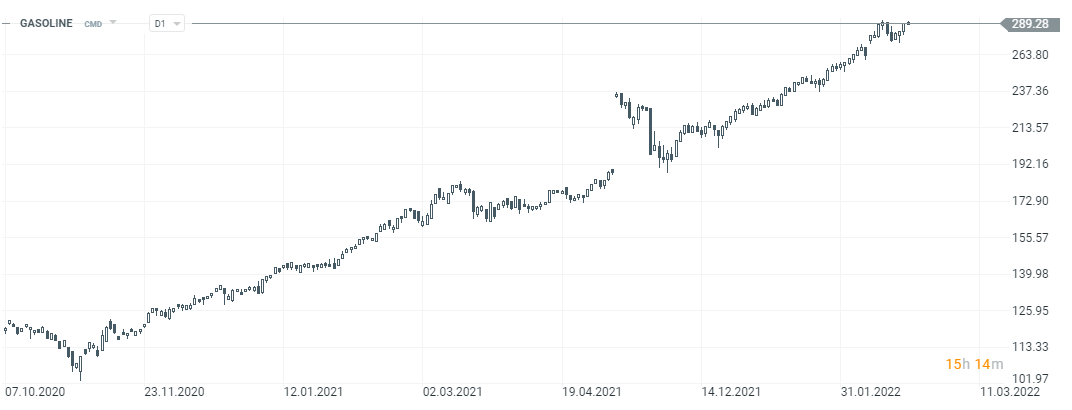
Petrol graph (gasoline), interval D1. Source: xNUMX XTB.
READ: How to Invest in Oil? [Guide]
Gasoline - what influences its price?
Gasoline is produced from the processing of crude oil. Therefore, it is a product whose price depends on a number of factors. Among them can be mentioned:
- Oil price - it is not surprising that the price of gasoline depends on the costs of obtaining the raw material for its processing in refineries. If the price of crude oil rises, the refining margin decreases and the price of gasoline increases. The more expensive the raw material cost is the higher the production price, which translates into the price of gasoline. On the other hand, a fall in the price of crude oil will, over time, translate into a recovery in the refining margin and a reduction in the price of gasoline.
- Political factors - the price of crude oil results from the shaping of the demand and supply for this raw material. Sometimes there is a sharp decline in supply as a result of political pressure. An example was the oil shocks in the 70s. Arab countries reduced the supply of crude oil, which was reflected in lower gasoline production. As a result, there was rationing of access to fuels in the USA and Western Europe. The opposite example was the increase in the supply of crude oil in 2015, which contributed to the decline in its price. After some time, the price of gasoline began to decline. Sometimes a policy can artificially raise the price (taxes) or lower it (regulate prices).
- Economic factors - economic growth increases the demand for fuels. This is due to the greater intensity of transport and greater private consumption. In the event of a sharp economic downturn, fuel consumption declines. Both among corporate and individual clients. An example of a decline in fuel prices was 2020. The reason was the spread of the coronavirus epidemic, which resulted in extensive restrictions on the movement of US citizens. As a result, the RBOB price in Los Angeles fell below $ 1 a gallon.
Alternative energy sources also influence gasoline prices. These include LPG and the development of electric cars. In the future, the decline in gasoline consumption will affect the oil industry, which will have to reduce its capacity to convert oil into gasoline.
How to invest in gasoline (RBOB gasoline)
There are many reasons why an investor may be interested in investing in gasoline priced financial instruments. Investors can invest in gasoline to protect themselves from rising transportation costs or to protect themselves from inflation. There are many ways to get exposure in this market.
Among them, the investment can be mentioned by:
- Futures contracts,
- CFDs,
- Oil company shares,
- ETFs, ETNs, ETCs.
Futures contracts
One of the most popular ways to earn an accurate prediction of gasoline prices is to invest through futures contracts on ROB Gasoline. They are traded on CM extension.
One contract has a face value of 42 gallons (approximately 000 liters), or approximately $ 4,546. liters.
As you can see, investing through futures is possible for investors with rich portfolios. Contrary to appearances, it is not an instrument with low liquidity. On February 18, 2022, the turnover for the April contract amounted to over 63. Investors in the futures market should be familiar with such terms as forward price, spot price, contagion and backwardation.
CFDs
A cheaper and more accessible alternative for retail investors are contracts for difference - CFDs (contracts for differences), where brokers require as little as $5 initial deposit to start trading. Among the popular brokers, CFDs based on gasoline offers Brokerage House X-Trade Brokers, Saxo Bank and Plus500.
| Broker |  |
 |
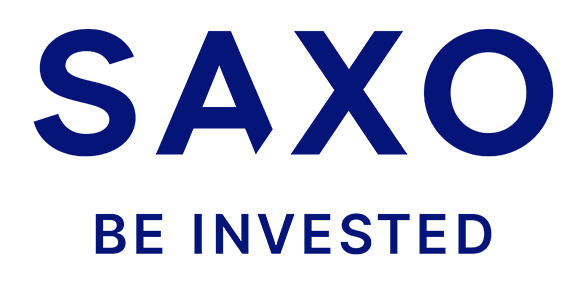 |
| End | Poland | Cyprus * | Denmark |
| Petrol symbol | GASOLINE | RB / Gasoline | GASOLINE |
| Min. Deposit | PLN 0 (recommended min. PLN 2000 or USD 500, EUR) |
PLN 500 | PLN 0 / EUR 0 / USD 0 |
| Min. Lot value | price * 420 USD | - | b / d |
| Commission | - | - | - |
| Platform | xStation | Plus500 platform | SaxoTrader Pro Saxo Trader Go |
* PLUS500 CY offer
CFDs are complex instruments and come with a high risk of losing money rapidly due to leverage. From 72% to 89% of retail investor accounts record monetary losses as a result of trading CFDs. Think about whether you understand how CFDs work and whether you can afford the high risk of losing your money.
Fuel company shares
Another possibility is the acquisition of crude oil processing companies and running their own petrol stations. Downstream companies benefit from lower crude oil prices as oil processing costs fall. Such a company can rebuild its refining margin even with a reduction in gasoline prices. Before investing in a company, it should be determined whether the company generates revenues mainly from crude oil processing (downstream) or from its production (upstream). Many American companies combine upstream and downstream activities.
Among the companies in the oil processing industry, the following can be mentioned:
- Exxon,
- chevron,
- Royal DutchShell.
- Eagle,
- Lotus,
Exxon Mobil
It is the largest American company in the oil sector. The company is the heir of the Standard Oil Company of New Jersey. In 1973, the company was spun off from the Standard Oil structures. In 1999, Exxon merged with Mobil to form ExxonMobil. The company operates in both the downstream and upstream industries. ExxonMobil employed 2020 employees in 72. The company has over 000 billion barrels of proven crude oil reserves. The company also has over 7 service stations in the United States and in foreign markets. The upstream segment has the greatest impact on the results. In 10, this segment generated over $ 000 billion in net loss. By comparison, the downstream segment lost $ 2020 billion. By investing in this company, the investor indirectly gains exposure to both crude oil and natural gas as well as products resulting from the processing of crude oil (including gasoline).
| Exxon | 2017 | 2018 | 2019 | 2020 |
| revenues | $ 237,162 billion | $ 279,332 billion | $ 255,583 billion | $ 178,574 billion |
| operational profit | $ 12,074 billion | $ 22,124 billion | $ 12,766 billion | $ 29,448 billion |
| operating margin | 5,09% | 7,92% | 4,99% | -16,49% |
| net profit | $ 19,710 billion | $ 20,840 billion | $ 14,340 billion | $ 22,440 billion |
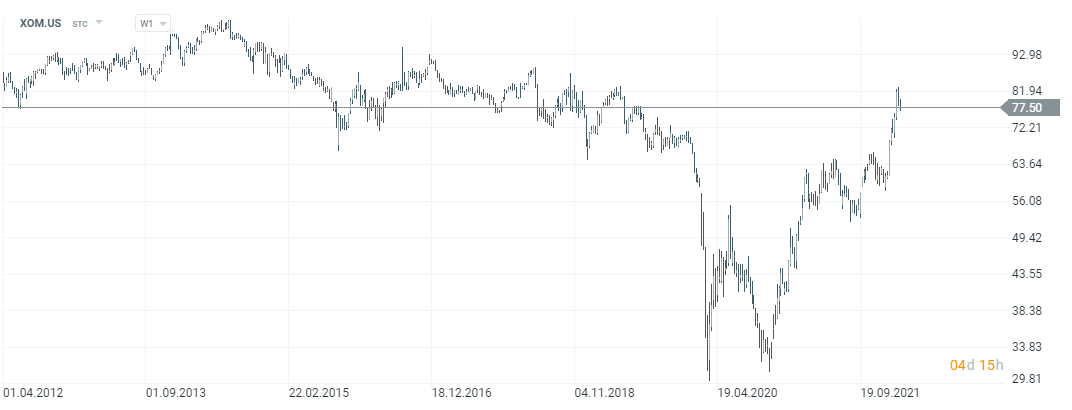
Exxon Mobil stock chart, interval W1. Source: xNUMX XTB.
Chevron
It is the second largest company operating in the US oil sector. In 2020, Chevron was ranked 61st on the Forbes Global 2000 ranking. The company was created as a result of the Sherman Antitrust Act, which was shared in 1911 by the powerful Standard Oil. The split resulted in the creation of Standard Oil of California. 1984 brought further changes due to the merger of Standard Oil and Gulf Oil. The name of the company was also changed to Chevron. Like Exxon, Chevron operates in the downstream and upstream markets. It also has midstream activities and has started to enter the new energy market more strongly. In 2020, Chevron generated $ 47 million in downstream profit and posted a loss of $ 2,4 billion on upstream operations. It is an investment of a similar type to Exxon. The investor obtains exposure to both the upstream and downstream segments.
| Chevron | 2017 | 2018 | 2019 | 2020 |
| revenues | $ 134,674 billion | $ 158,902 billion | $ 139,865 billion | $ 94,471 billion |
| operational profit | $ 2,480 billion | $ 14,446 billion | $ 0,100 billion | $ 6,097 billion |
| operating margin | 1,84% | 9,09% | 0,07% | -6,45% |
| net profit | $ 9,195 billion | $ 14,824 billion | $ 2,924 billion | $ 5,543 billion |
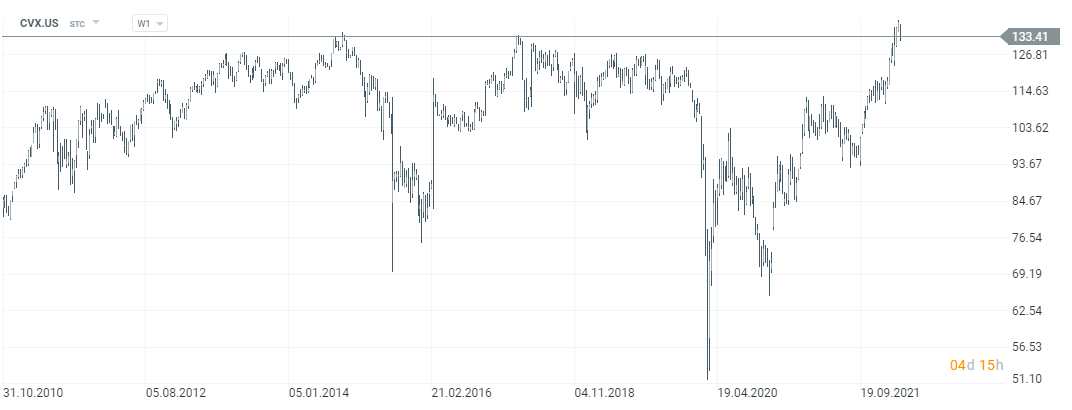
Chevron stock chart, interval W1. Source: xNUMX XTB.
Royal Dutch Shell plc
It is a British-Dutch petrochemical company based in the Dutch The Hague. RDS was established in 1907 as a result of the merger of the Dutch Royal Dutch Petroleum Company with the British Shell Transport and Trading Limited Company. In 2020, Forbes Global 2000 ranked the company 21st among the largest public companies in the world. Interestingly, in 2013 RDS was ranked first in the Fortune Global 500 ranking. In 2013, the company's revenues exceeded $ 470 billion, which corresponded to 84% of the Dutch GDP. RDS is a vertically integrated petrochemical company. It operates in the upstream, midstream and downstream segments. Royal Dutch Shell operates in over 70 countries. Daily production is equivalent to 3,4 million barrels of crude oil. In 2020, the company employed over 87 employees.
| Royal Dutch Shell | 2017 | 2018 | 2019 | 2020 |
| revenues | $ 305,179 billion | $ 388,379 billion | $ 344,877 billion | $ 180,543 billion |
| operational profit | $ 15,481 billion | $ 31,189 billion | $ 22,946 billion | $ 25,530 billion |
| operating margin | 5,07% | 8,03% | 6,65% | -14,14% |
| net profit | $ 12,977 billion | $ 23,352 billion | $ 15,842 billion | $ 21,680 billion |
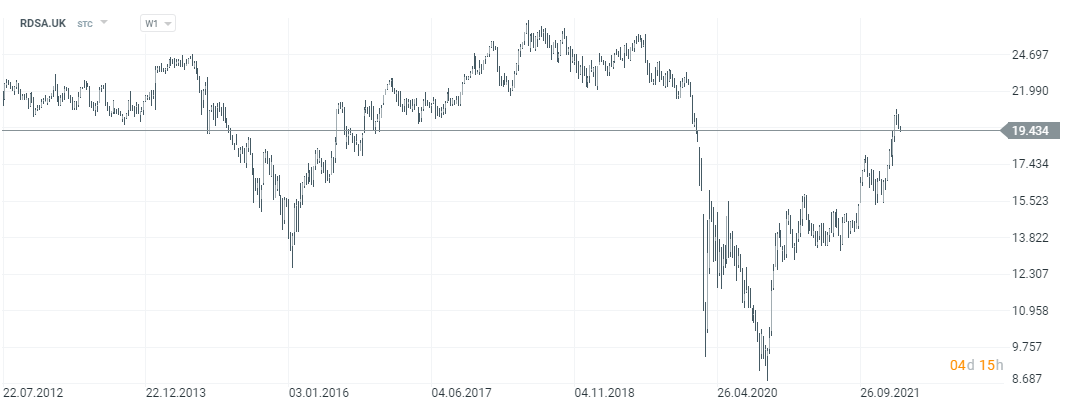
Royal Dutch Shell stock chart, interval W1. Source: xNUMX XTB.
PKN Orlen
It is a Polish fuel and energy concern listed on the Warsaw Stock Exchange. It is also one of the largest companies of this type in Central and Eastern Europe. Orlen has refineries in Poland, the Czech Republic and Lithuania. Their total processing capacity in 2020 was 36 million tonnes per year. Orlen has little hydrocarbon extraction activity. In 2020, production amounted to 16,2 thousand tonnes. barrels of crude oil equivalents per day. Orlen has a very extensive retail network. It has over 2500 petrol stations on 5 markets. The company is also developing an offer for owners of electric cars. The company has over 110 electric car fast charging stations. Orlen also has an energy branch that produces over 3,9 GW of electricity. PKN also took over the Ruch kiosk network and has a media branch, in 2020 Polska Press took over (the owner of such newspapers as Dziennik Bałtycki, Kurier Lubelski or Głos Wielkopolski). The acquisition of Lotos by Orlen is still in the preparation phase. The company's capitalization is currently around PLN 29 billion.
| orlen | 2017 | 2018 | 2019 | 2020 |
| revenues | PLN 95,364 billion | PLN 109,706 billion | PLN 111,203 billion | PLN 86,180 billion |
| operational profit | PLN 8,580 billion | PLN 6,441 billion | PLN 5,713 billion | PLN 0,021 billion |
| operating margin | 8,99% | 5,87% | 5,14% | 0,02% |
| net profit | PLN 6,655 billion | PLN 5,556 billion | PLN 4,300 billion | PLN 2,755 billion |
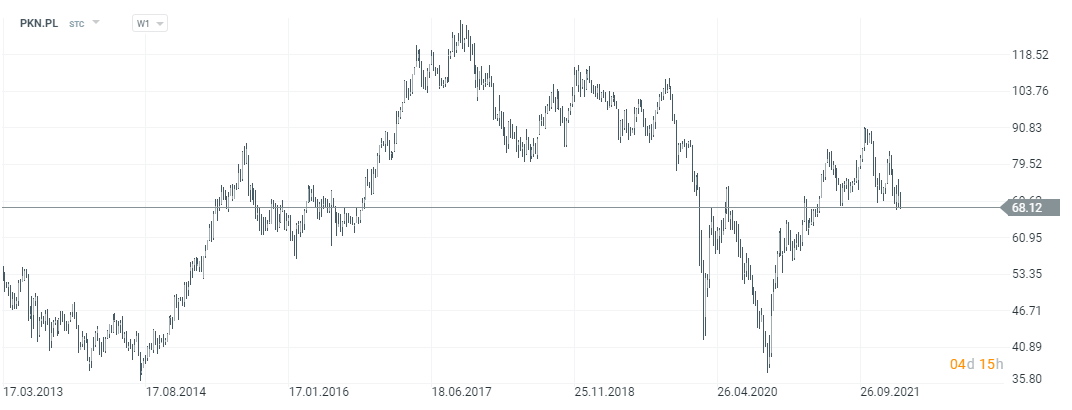
PLN Orlen stock chart, interval W1. Source: xNUMX XTB.
Lotos
It is the second largest oil refinery in Poland. Its origins go back to the Polish People's Republic. The company was founded in 1972 as the Gdańsk Refinery. The first production started in December 1975 (petrol, diesel). Five years later, asphalt production began. Until today, the main activity of the company is downstream and upstream. Lotos daily extracts over 20 thousand. barrels of oil equivalent. Currently, the majority shareholder of the company is the Polish State Treasury, which holds over 53% of shares. At the beginning of 2018, the process of merging PKN Orlen with Lotos began. The European Commission has agreed to the takeover on condition that the fuel stations owned by Lotos are sold and a 30% stake in the Lotos refinery. The current capitalization of the company exceeds PLN 9 billion.
| Lotos | 2017 | 2018 | 2019 | 2020 |
| revenues | PLN 24,186 billion | PLN 30,122 billion | PLN 29,493 billion | PLN 20,909 billion |
| operational profit | PLN 2,332 billion | PLN 2,614 billion | PLN 1,982 billion | -0,446 billion PLN |
| operating margin | 9,64% | 8,68% | 6,72% | -2,13% |
| net profit | PLN 1,672 billion | PLN 1,587 billion | PLN 1,153 billion | -1,146 billion PLN |

Lotos stock chart, interval W1. Source: xNUMX XTB.
Low-cost investment products
The investor can also take advantage of low-cost investment products. One of them are ETP (Exchange Trade Products). An example is UGA (United States Gasoline Fund LP). The product was created in 2008 and allows investors to gain exposure to the RBOB gasoline market. UGA invests funds in gasoline futures quoted on NYMEX (New York Mercantile Exchange).
Over the last 5 years, the average annual rate of return on this product has been over 11%.
As of February 18, the assets under management of this investment product were modest at just over $ 90 million. It is quite an expensive product because annual costs are 1,02%.
Where to invest in ETFs and stocks
More and more forex brokers have a wide range of ETFs in their offer.
For example on XTB Today, we can find over 3500 equity instruments and 400 ETFs, a Saxo Bank over 19 companies and 000 ETF funds.
| Broker |  |
 |
 |
| End | Poland | Denmark | Cyprus * |
| Number of exchanges on offer | 16 exchanges | 37 exchanges | 24 exchanges |
| Number of shares in the offer | approx. 3500 - shares circa 2000 - CFDs on shares |
19 - shares 8 - CFDs on shares |
approx. 3 - CFD on shares |
| The amount of ETF on offer | approx. 400 - ETF approx. 170 - CFD on ETF |
3000 - ETF 675 - CFD on ETF |
approx. 100 - CFD on ETF |
| Commission | 0% commission up to EUR 100 turnover / month | according to the price list | Spread depends on the instrument |
| Min. Deposit | PLN 0 (recommended min. PLN 2000 or USD 500, EUR) |
0 PLN / 0 EUR / 0 USD | PLN 500 |
| Platform | xStation | SaxoTrader Pro Saxo Trader Go |
Plus500 platform |
* PLUS500 CY offer
CFDs are complex instruments and come with a high risk of losing money rapidly due to leverage. From 72% to 89% of retail investor accounts record monetary losses as a result of trading CFDs. Think about whether you understand how CFDs work and whether you can afford the high risk of losing your money.






















![Forex Club – Tax 9 – Settle tax on a foreign broker [Download the Application] Forex Club - Tax 9](https://forexclub.pl/wp-content/uploads/2024/02/Forex-Club-Podatek-9-184x120.jpg?v=1709046278)
![Trading View platform – solutions tailored to the needs of traders [Review] trading view review](https://forexclub.pl/wp-content/uploads/2024/03/trading-view-recenzja-184x120.jpg?v=1709558918)
![How to connect your FP Markets account to the Trading View platform [Guide] fp markets trading view](https://forexclub.pl/wp-content/uploads/2024/02/fp-markets-trading-view-184x120.jpg?v=1708677291)
![How to invest in ChatGPT and AI? Stocks and ETFs [Guide] how to invest in chatgpt and artificial intelligence](https://forexclub.pl/wp-content/uploads/2023/02/jak-inwestowac-w-chatgpt-i-sztuczna-inteligencje-184x120.jpg?v=1676364263)




![Izabela Górecka – “Success on the market depends not only on knowledge, but also on emotional stability” [Interview] Izabela Górecka - interview](https://forexclub.pl/wp-content/uploads/2024/04/Izabela-Gorecka-wywiad-184x120.jpg?v=1713870578)
![WeWork – the anatomy of the collapse of a company valued at $47 billion [WeWork, part II] wework bankruptcy story](https://forexclub.pl/wp-content/uploads/2024/04/wework-bankructwo-historia-184x120.jpg?v=1711729561)
![Adam Neumann – the man who screwed up Softbank [WeWork, part AND] adam neumann wework](https://forexclub.pl/wp-content/uploads/2024/04/adam-neumann-wework-184x120.jpg?v=1711728724)




![The most common mistakes of a beginner trader - Mr Yogi [VIDEO] Scalping - The most common mistakes of a beginner trader - VIDEO](https://forexclub.pl/wp-content/uploads/2024/03/Scalping-Najczestsze-bledy-poczatkujacego-tradera-VIDEO-184x120.jpg?v=1711601376)
![Learning patience: No position is also a position - Mr Yogi [VIDEO] Scalping - Learning patience - No position is also a position - VIDEO](https://forexclub.pl/wp-content/uploads/2024/03/Scalping-Nauka-cierpliwosci-Brak-pozycji-to-tez-pozycja-VIDEO-184x120.jpg?v=1710999249)
![When to exit a position and how to minimize losses - Mr Yogi [VIDEO] Scalping - When to exit a position and how to minimize losses - VIDEO](https://forexclub.pl/wp-content/uploads/2024/03/Scalping-Kiedy-wyjsc-z-pozycji-i-jak-minimalizowac-straty-VIDEO-184x120.jpg?v=1710336731)



![How to invest in gasoline? [Guide] how to invest in gasoline - gasoline](https://forexclub.pl/wp-content/uploads/2022/02/jak-inwestowac-w-benzyne.jpg?v=1645522153)

![How to invest in Feeder Cattle? [Guide] how to invest in livestock - feeder cattle](https://forexclub.pl/wp-content/uploads/2023/09/jak-inwestowac-w-bydlo-hodowlane-feeder-cattle-300x200.jpg?v=1693821591)

![How to invest in gasoline? [Guide] increase in raw material prices](https://forexclub.pl/wp-content/uploads/2022/02/podwyzka-cen-surowcow-102x65.jpg?v=1645522782)
![How to invest in gasoline? [Guide] war russia's invasion of ukraine](https://forexclub.pl/wp-content/uploads/2022/02/wojna-inwazja-rosji-na-ukraine-102x65.jpg?v=1645528739)










Leave a Response